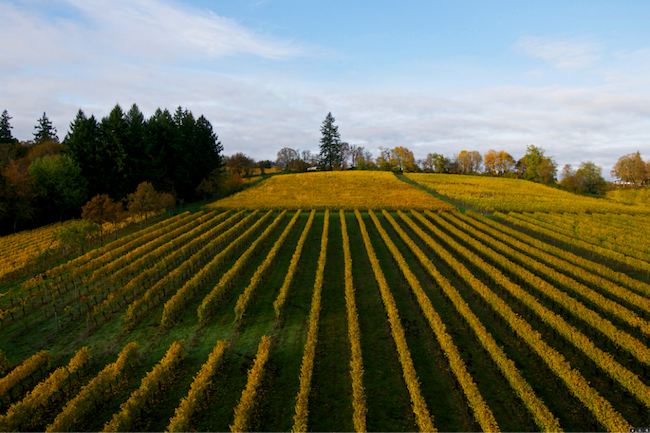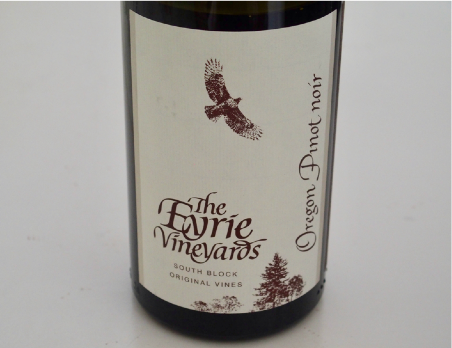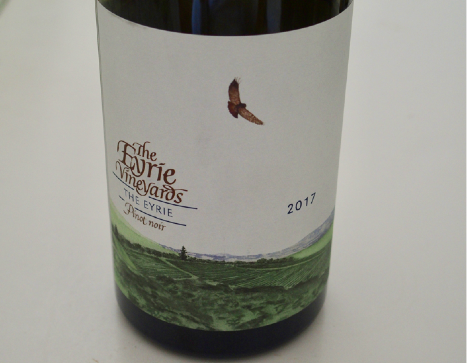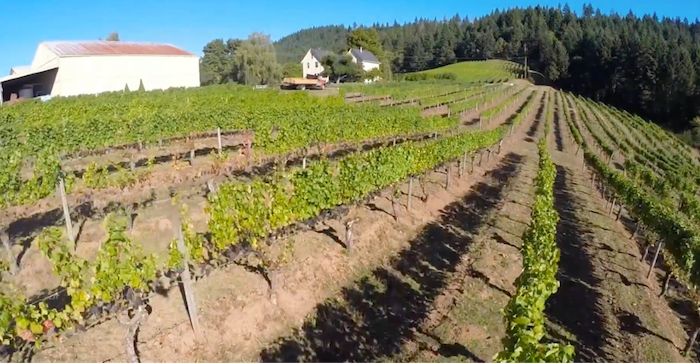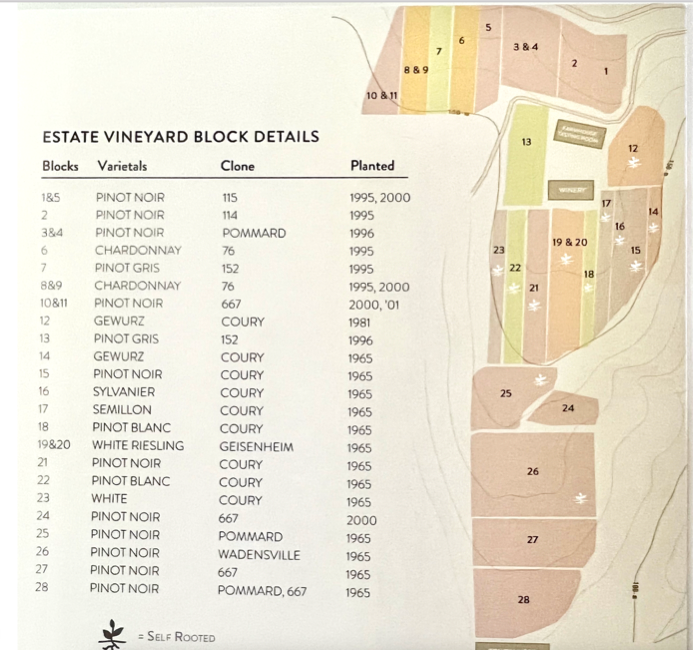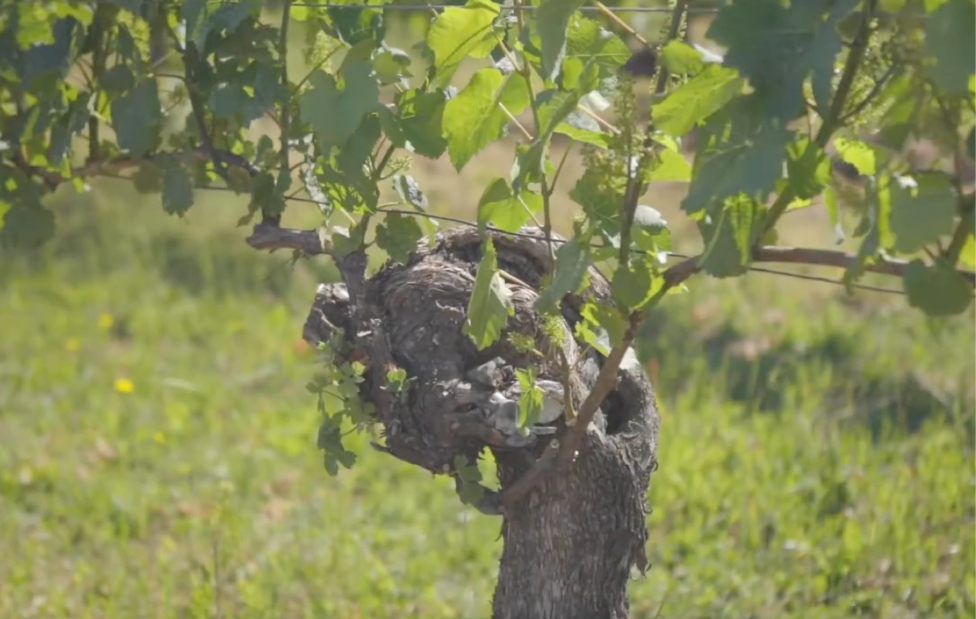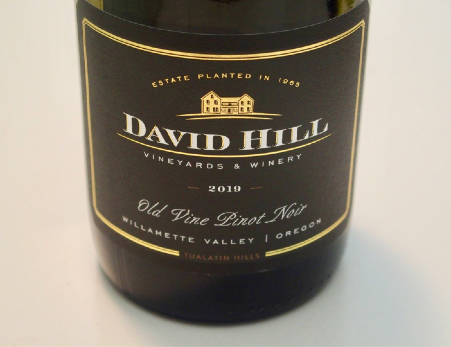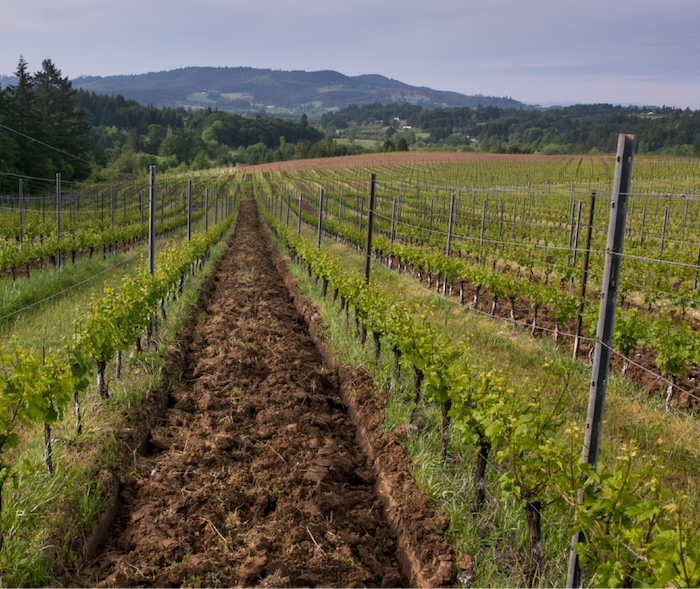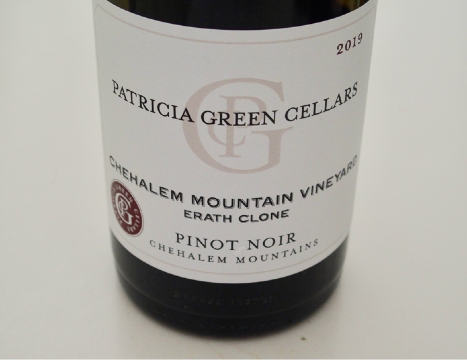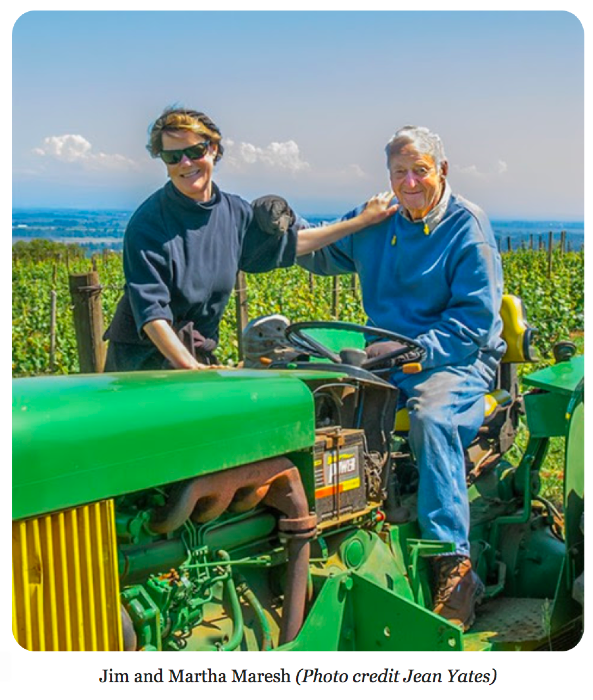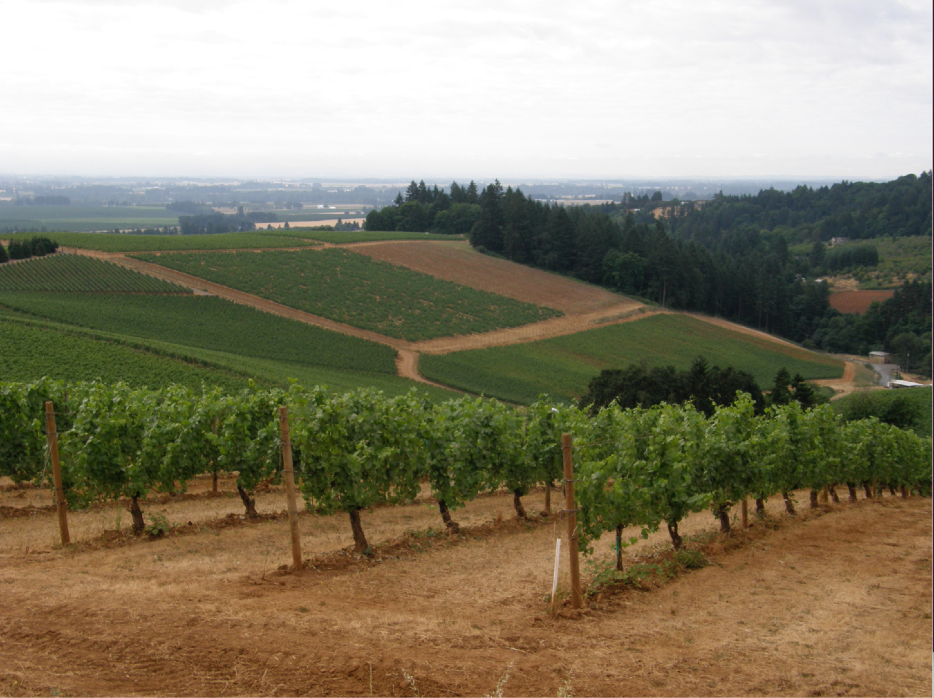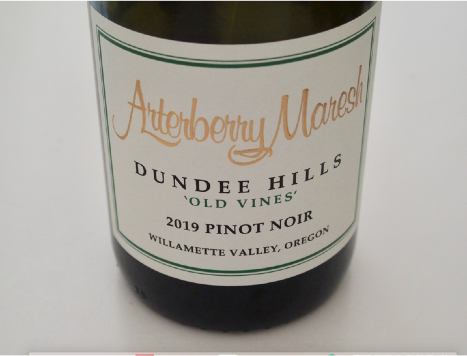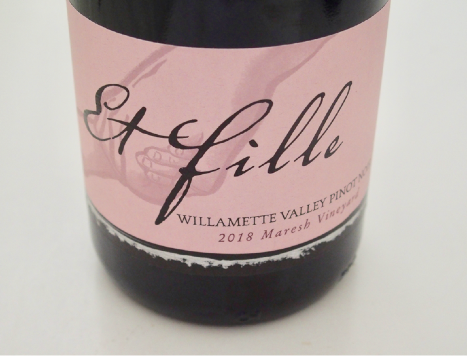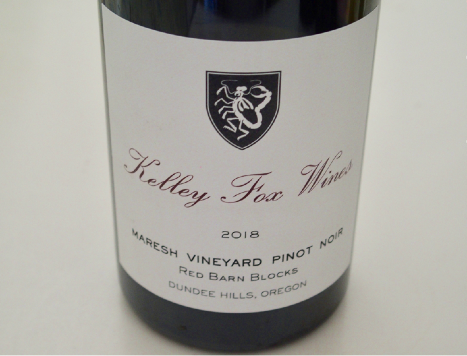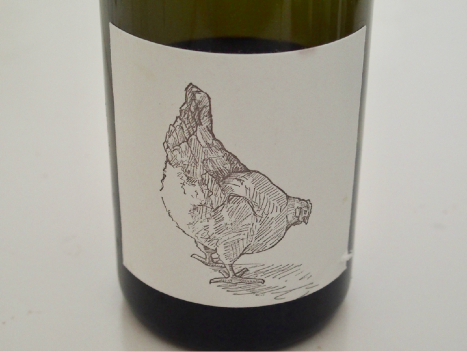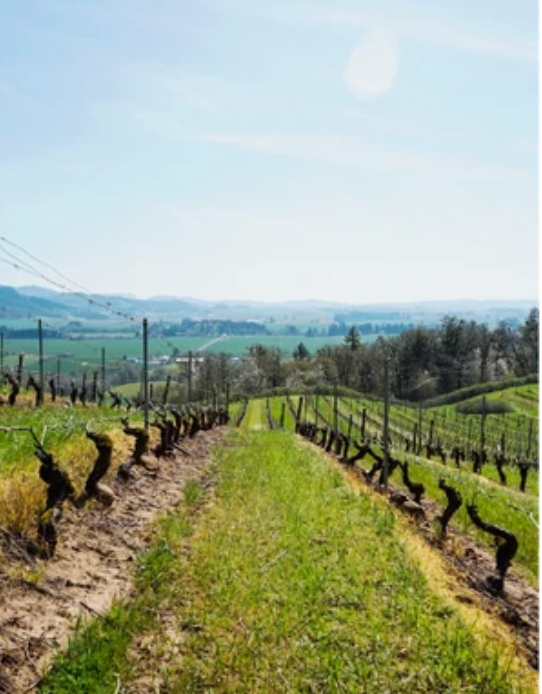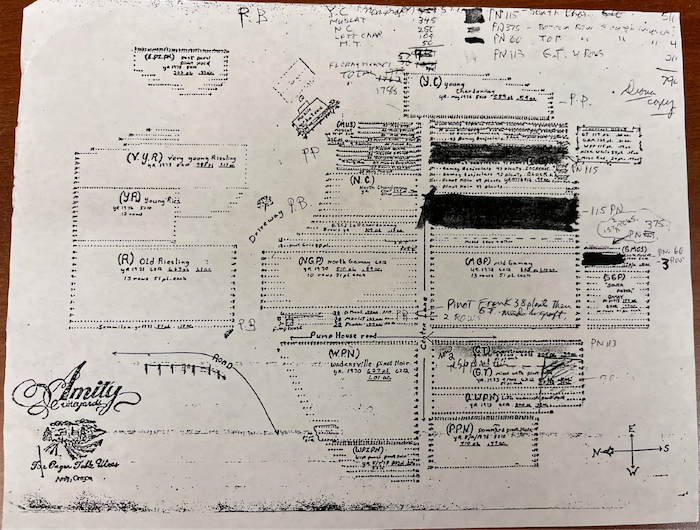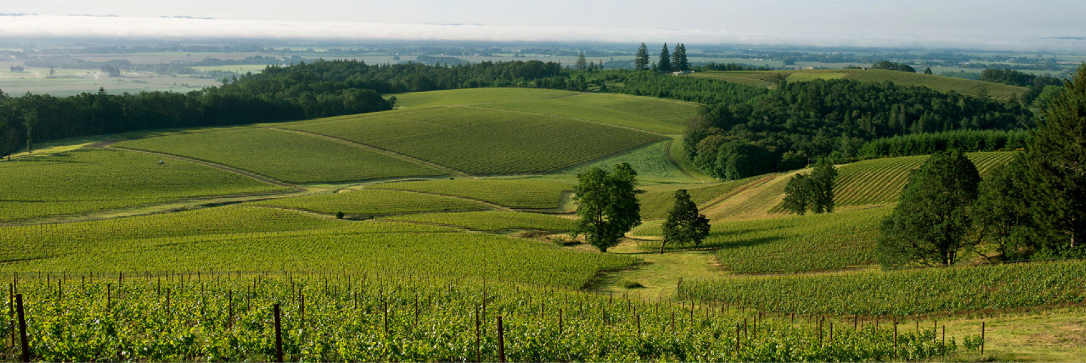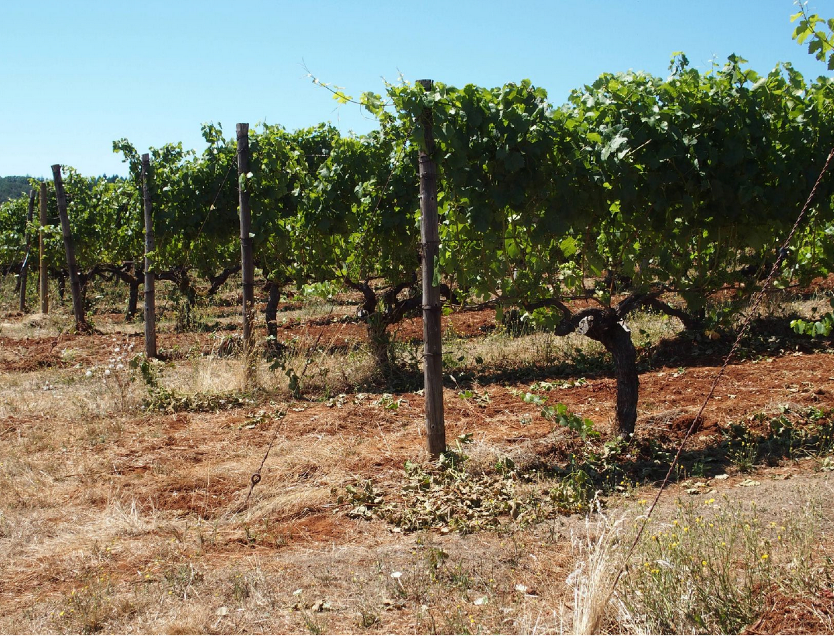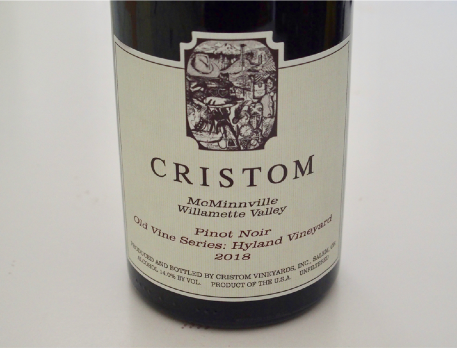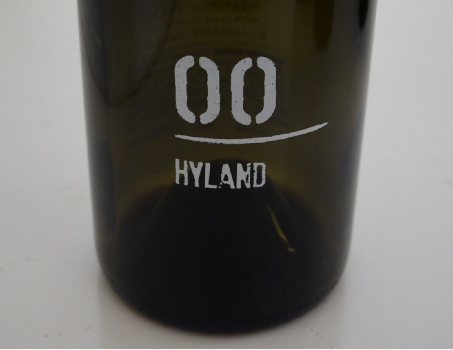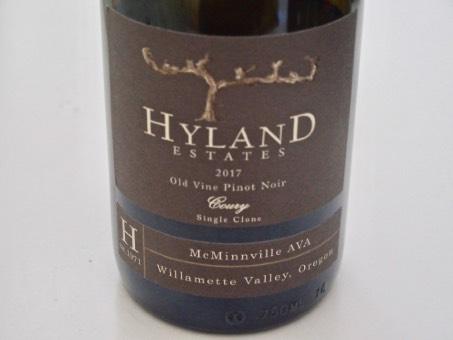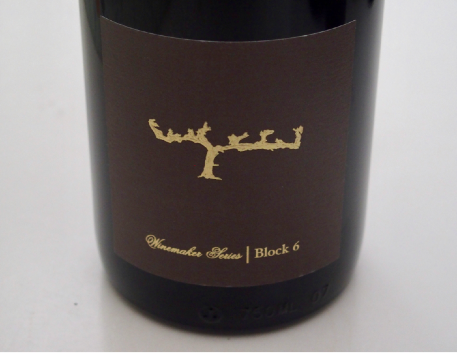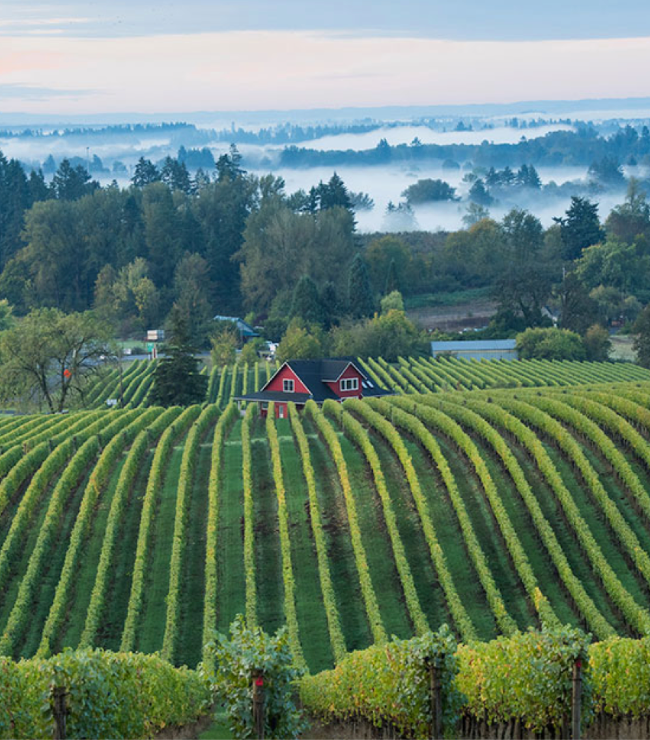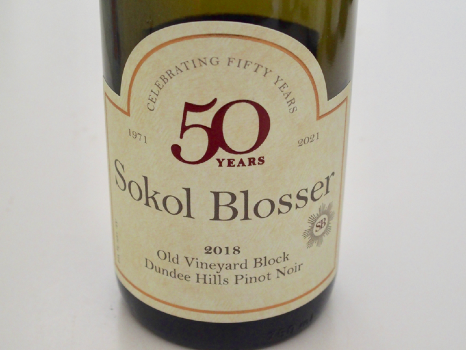Vineyards Established 1965-1971
1965-1969
The Eyrie Vineyard
The Eyrie Vineyard Original Vines (courtesy Jason Lett)
Owners: The winery was founded by David and Diana Lett in 1965. Son and winemaker Jason Lett took over
management in 2005. David passed away at the age of 69 in 2008.
Location: Dundee Hills AVA
Planting: The original plantings consisted of 6.5 acres of Pinot Noir between 1965 and 1974. The initial
February 1965 plantings were in Corvallis and moved to the Dundee Hills in 1966. 5 acres of the original
plantings are still in production.
Pinot Noir Scions: Own-rooted Wädenswil 1A and Pommard 5 with a small amount of Upright Pinot clone 18.
The Pinot Noir was sourced from Wente in California.
Soil: Volcanic (Nekia and Gelderman) and sedimentary (Woodburn, Dayton and Amity)
Vines: 10’ alley for most of the vineyard with 12’ in the South Block, with 6’ vine spacing. Aspect is south-facing
at 260’- 410’ elevation.
Farming: Vines are non-irrigated. Herbicides have never been used. Farming is regenerative with no till, no
fertilizer, and farmed since planted organically with organic certification in 2013.
Winery clients: No clients, a monopole.
Old vines bottlings: The first vintage of Pinot Noir was 1970. Pinot Noir production currently includes Estate
Pinot Noir (containing a small amount of original vine fruit),The Eyrie Original Vines Pinot Noir (100%
original vines), and the South Block Reserve Pinot Noir (100% original vines).
Of Interest: Small amounts of Chardonnay (Draper selection), Pinot Gris, Riesling, Gewürztraminer, Muscat
Ottonel, Pinot Blanc (actually Melon de Bourgogne), Pinot Meunier and Petite Sirah were planted in the initial
years. Since the original Pinot Noir vines are own-rooted, they are struggling to survive due to phylloxera
infestation. Jason notes, “I am very sad to see this. We are in the process of replanting vines on rootstick as
they pass away. Another option has been to re-trunk them in situ by growing a shoot from the base of the plant,
train it up, and create a new trunk (this is not something you can do on rootstock vines)."
2014 The Eyrie Vineyards South Block Dundee Hills Pinot Noir
$180.10 rows at the corner of the vineyard among the first
vines planted (1968). There is a confluence of four interlocking
soils and a unique exposure and climate such that it produces a
wine distinct from neighboring vines. Within 7 years of planting,
the winery began bottling these rows separately and named the
wine “South Block.” This was the first American Pinot Noir to
compete successfully against renowned wines of Burgundy at
1979 Paris and 1990 Beaune competitions. David Lett stopped
releasing South Block after the victories and kept a few cases of
each vintage in the cellar planning to release the wines years or
even decades later.
·
Moderate garnet color in the glass. Alluring
aromas of cherry, black raspberry, dried red rose petal and spicy
oak. Light to mid-weight in style with deep, engaging flavors of
red cherry, cranberry, blueberry, plum, and spice. A gorgeous
and sophisticated wine with gentle power, refreshing juiciness,
impeccable balance, and an extremely long, scented finish.
Score: 96
2016 The Eyrie Vineyards The Eyrie Original Vines Dundee Hills Pinot Noir
13.0% alc., $70.
·
Dark garnet
color in the glass. The wine’s nose continually evolves in the glass over time. The more you smell, the more
you find. Aromas of sous-bois, dark cherry, exotic spices, toasted waffle, and dried rose petal. Mid-weight plus
in concentration with fruit flavors of black cherry and cranberry. Some of the unique flavors deny description.
Somewhat plush on the palate with minimal tannins and welcome harmony. The finish is long and sensual.
Score: 94
2017 The Eyrie Vineyards The Eyrie Original Vines Dundee Hills Pinot Noir
13.0% alc., $70.
·
Light garnet color in the
glass. Lovely aromas of red rose, red cherry, sandalwood and
spicy oak. Elegantly styled and lacy, with a lighter weight
impression but more power that expected considering the light
color.Very easygoing, with bright acidity, gossamer tannins
and a finish with unusual length and generosity. Seductive
rather than hedonistic.
Score: 93
2018 The Eyrie Vineyards The Eyrie Original Vines Dundee Hills Pinot Noir
13.0% alc., $85.
·
Moderate
garnet color in the glass. Aromas of strawberry, red cherry, red licorice, baking spices, bramble, and inviting
oak soar over time in the glass. Elegant in a lighter-weighted style that is very suave in the mouth. There is
both fruit flavors of red and blue berries as well as a savory bent of dried herbs. Dusty tannins, a shadow of
oak and a very long finish completes the picture. Dare I say “Burgundian?”
Score: 94
Charles Coury Vineyard/David Hill Vineyard
David Hill Vineyard
Owners: Charles and Shirley Coury acquired a 45-acre property with an abandoned vineyard and operated a
vineyard, a nursery, and a winery (Charles Coury Vineyards) until 1978 when the Courys became financially
strapped and the operation was sold. The vineyard changed hands many times over the years until Milan and
Jean Stoyanov acquired the property in 1992 when they renamed it David Hill Vineyards & Winery. The winery
name honors the Frederick David Family that once lived in the hilly area and planted the first vineyard on the hill
originally known variously as Reuter Hill, David’s Hill, and Wine Hill prior to the Forest Grove designation.
Location: Forest Grove, OR, in the Tualatin Hills AVA.
David Hill Estate Vineyard Block Details
Planting: Charles Coury put his initial cuttings into the ground in April 1965 at David Lett’s nursery in Corvallis,
two months after Lett’s original plantings. The Courys acquired their vineyard property in what is now Forest
Grove in October 1965. They established Charles Coury Vineyards in 1966 when the rooted 1965 vines were
transferred and planted. The details of the original plantings are not entirely clear but the current General and
Vineyard Manager Mike Kuenz told me the following. Today, David Hill farms 15.5 acres of original plantings
including Pinot Noir and 13 aromatic white varieties. The original Pinot Noir vines are in four blocks: Block 26 is
4.5 acres of Wädenswil clone, Block 25 is 1.3 acres of Pommard clone, Block 21 is 2 acres of multiple unique
Coury selections of Pinot Noir and some other unidentified red varieties, and Block 15 is 1 acre of Coury Pinot
Noir selections different from those in Block 21. Dijon 114, 115, and 667 were added in 1995 and 2000.
Pinot Noir Scions: The original Pinot Noir planted was own-rooted Wädenswil (? 3A), Pommard (? 4), and
possibly non-heat treated origins) and the Coury selection (often referred to as the “Coury clone,” but actually
selections of Pinot Noir suit cased from Alsace, France by Charles Coury). According to a regional historian,
Kerry McDaniel Boenisch, Coury said, “I did bring back rootstock from Alsace in a suitcase. It was called the
Bergheimer clone.” He also shipped cuttings to the agricultural quarantine port in San Francisco where he
picked them up and drove them to Oregon.
Soil: Laurelwood soil series.
Vines: South-facing site. At some point, the old vines were transitioned to cordon pruned (about 2004-2011)
with extremely low yields. After several years, the vines are now cane pruned with more healthy yields.
Farming: LIVE certified, no-till farming. No phylloxera to date, partly due to the seclusion of the vineyard and the
surface of the wind-blown loess in the Laurelwood soil series.
Winery clients: Today, almost all vineyard yields are devoted to David Hill Vineyard & Winery production under
the direction of winemaker Chad Stock. A minuscule amount of original Pinot Noir has been sold to Golden
Cluster and that winery also bottles Semillon from the David Hill Vineyard.
Old vines bottlings: The winery’s flagship old-vine bottling is the Estate Black Jack 21 Pinot Noir produced
from Block 21 Coury selections planted in 1966. Another bottling containing fruit from all three original blocks
was labeled Reserve until 2015 when the name was changed to “Old Vine”. A limited amount (25 cases) of
old vine Charles Coury Vineyard Pinot Noir was produced by Golden Cluster beginning in 2018.
David Hill Estate Vineyard old vine Pinot Noir
Of Interest: Coury’s original plantings also included Sylvaner, Gewürztraminer, Muscat, Pinot Gris, Riesling
and Semillon. Under the direction of winemaker Richard Wirtz, Coury Winery produced Pinot Noir, Chardonnay,
Gewürztraminer and Zwicker (a blended white wine). Coury also produced a Gamay (Upright Pinot). Today, the
David Hill Winery produces highly lauded white wines from these original plantings.
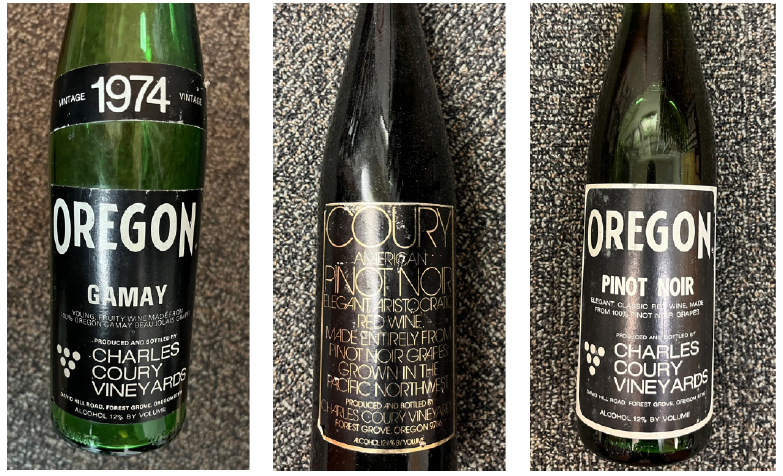
2016 David Hill Black Jack 21 Tualatin Hills Willamette Valley Pinot Noir
14.1% alc.,pH 3.68, TA 0.57, $55.
Aged 14 months in French oak barrels, 30% new. Unfiltered.
·
Moderately dark garnet color in the glass. Aromas
of well-ripened black fruits. Mid-weight plus richly layered flavors of black raspberry, black cherry, blackberry,
cassis, and spice. Seamless texture, with a dusting of tannins, tailing off at the finish like silk. Bold and dense
in this vintage but enjoyable. Much better when tasted the following day from a previously opened bottle.
Score: 91
2018 David Hill Black Jack 21 Tualatin Hills Willamette Valley Pinot Noir
14.4% alc., pH 3.91, TA 0.56,
$55. Aged 16 months in French oak barrels, 40% new.
·
Moderately light garnet color in the glass. The nose
features very ripe purple and black fruits with hints of orange peel, pipe smoke, sweet compost and floral lift.
Noticeably muscular tannins initially frame the mid-weight core of dark cherry, blueberry and pomegranate fruit
flavors. More refined, with less evident tannins and a noticeably long finish when tasted the following day.
Score: 90
2019 David Hill Old Vine Willamette Valley Pinot Noir
13.4%
alc., pH 3.59, TA 0.61, $70. A combination of Pommard and
Wädenswil clones and Coury selection planted in “1965.” Aged
18 months in French oak barrels, 5% new and 95% neutral.
·
Moderate garnet color in the glass. Aromas of red cherry,
sandalwood and sweet mulch. Delightful core of fresh spiced
cherry flavor. Elegantly composed and charming, with a silken
texture, suede tannins and a finish that seems to linger for at
least a minute. This wine is clearly recognizable as a special old
vine Pinot Noir that has me searching for superlatives. Reminds
me of a great 1er Cru red Burgundy.
Score: 95
Chehalem Mountain Vineyard
Chehalem Mountain Vineyard
Owner: In 1968, Dick Erath purchased 48.92 acres from Mrs Dopp, whose family had homesteaded the
property. He sold the vineyard in 1986. The vineyard was acquired more recently by Capra Vineyards, founded
by Judy Jordan after the sale of J Vineyards & Winery to E.&J. Gallo. In December 2021, Cooper Mountain
Vineyards purchased the vineyard.
Location: Dopp Road across the street from the eastern border of Ribbon Ridge in the Chehalem Mountains
AVA.
Planting: Dick Erath told me through a recent personal communication that a total of 8 acres of own-rooted
Pinot Noir was originally planted between 1969 and 1978. It is commonly reported in the wine literature, winery
promotions and the current vineyard’s website that the vineyard dates to 1968. According to Paul Pintarich’s
detailed account of the early Oregon winegrowers in The Boys Up North, Erath moved to the Willamette Valley
in 1968 and spent that year clearing the land in preparation for planting while his cuttings were nurtured by
Charles Coury. Pintarich dated the planting of 4 acres of Pinot Noir, Riesling and Gewürztraminer to the spring
of 1969. Today, the original Pinot Noir plantings consist of 2.3 acres designated as Block D3, and the 1978
planting of 2.11 acres is designated Block E1.
Pinot Noir Scions: The initial planting was an own-rooted Wädenswil clone followed by an own-rooted Pommard
clone. The 1978 planting was an own-rooted Pommard clone.
Soil: Willakenzie sedimentary series
Vines: The vineyard is at 300’-520’ elevation and primarily south-facing with some southwest facing aspect.
There is a variety of vine spacing in each block but the original vines were planted 12’ x 6’.
Farming: Dry-farmed. Cooper Mountain vineyards plan to convert the vineyard to organic and biodynamic
farming.
Winery clients: Aberrant Cellars (2014-2016), Minimus (2016), and more recently Double Zero (OO) Wines
and Failla. Patricia Green Cellars picked up the 1978 planted block E1 in the 2019 vintage. The future is in
question with the acquisition of the vineyard by Cooper Mountain Vineyards.
Old vines bottlings: Craft Wine Co. Chehalem Mountain Vineyard Pinot Noir, Patricia Green Cellars
Chehalem Mountain Vineyard Erath Clone Pinot Noir (the clone is actually Pommard, not the so-called
Erath clone).
Of interest: The vineyard now has 33.5 acres planted to Pinot Noir and Chardonnay including 31.5 acres of
Pinot Noir (seven clones). 18 additional acres of Pinot Noir and Chardonnay are being developed on the site.
2016 Minimus “1968” Chehalem Mountain Vineyard Chehalem Mountains Pinot Noir
12.7% alc., $70.
Produced by Craft Wine Co, in Carlton, OR.
·
Moderate garnet color in the glass. The nose is dusty and nutty
with a hint of red cherry. More expressive on the palate with a juicy core of red berry and cherry fruit flavors
framed by an arrow of vibrant acidity and a dusting of silky tannins. A petrol note may come from oak. The
modestly persistent, raspberry-fueled finish is satisfying.
Score: 90
2019 Patricia Green Cellars Chehalem Mountain Vineyard Erath Clone Chehalem Mountains Pinot Noir
13.1% alc.
$60. Grapes are from the 1978 planting of own-rooted
Pommard.
·
Dark garnet color in the glass. Profuse aromas of
sous-bois, darker fruits and rose petal. Mid-weight plus in style
with the dense essence of blackberry, cassis and boysenberry
fruits backed by beefy tannins. There are hints of cola, black
tea leaves and oak. Somewhat rustic, with a mildly astringent
finish. Slightly aloof initially but more engaging when tasted
the following day. A good cellar candidate.
Score: 92
Ponzi Estate Vineyard
Owners: The Ponzi family established this vineyard in 1969 at a time there were only four wineries in Oregon.
Ponzi Vineyards (established in 1970) was sold to the Bollinger family, owners of Champagne Bollinger, in
2021.
Location: Sherwood, Oregon, in the Laurelwood District AVA.
Planting: 2 acres of own-rooted Pinot Noir planted on a 20-acre site. Interplanting began in 1980. The original
vines are still in full production according to Luisa Ponzi.
Pinot Noir scions: Own-rooted Pommard 4 from Wente’s Arroyo Seco increase block and UCD 18 (GB) from
another increase block farmed by Mirassou.
Soil: Laurelwood series. Soils are very sandy loam so old age as opposed to phylloxera will eventually lead to
decline.
Vines: Southeast-facing vines originally planted with 9’ x 7’ spacing. Interplanting in 1980 increased spacing.
Winery clients: None, a monople.
Old vines bottlings: None. The Pinot Noir goes into the winery’s Rosé or Tavola Pinot Noirs.
Of Interest: The vineyard also has Chardonnay 108 that goes into the winery’s Blancs de blanc and Reserve
Chardonnay, Pinot Gris that goes into the “Old Vine: Pinot Gris blend, and Riesling into the winery’s Riesling.
Reportedly, some of the original plantings included some “Pinot Blanc” acquired from David Lett that turned out
to be Melon.
William Sims Family Vineyard
William Sims acquired a parcel of land near the city of Roseburg (in what is now the Umpqua Valley AVA) in the late
1960s and planted a small vineyard. The exact date of planting is not known but is reportedly around 1969. The
vineyard was sold in the mid-2000s and probably renamed.
Cuttings for Pinot Noir, Gamay, Chenin Blanc and Pinot Blanc were obtained from Concannon Vineyards in California.
Early winery clients included HillCrest Vineyards, Girardet Vineyards, Davidson, Forgeron, and Callaham Ridge.
William Sims was one of the charter members of the Oregon Wine Growers Association. He passed away at the age of
93 in 2021.
1970-1971
Maresh Red Hills Vineyard
Owners: Martha Maresh (Jim and Loie’s daughter) and her husband Steve Mikame now manage the vineyard
and Red Barn Tasting Room, along with the third-generation winemaker Jimmy Arterberry-Maresh. Jim Maresh
Sr., who developed a reputation as a respectful steward of the land, died in 2021.
Location: High in the Dundee Hills on NE Worden Hill Rd. in the Dundee Hills AVA
Planting: Jim and Loie Maresh bought a 27-acre farm in the Dundee Hills in 1959. They eventually expanded
their holdings to 160 acres. Vineyard folklore relates that Dick Erath drove to the property without notice in
1969 and told Jim that he was sitting on a great viticultural site. Jim took his advice and in 1970 planted 1.5
acres of own-rooted Wädenswil clone Pinot Noir in front of the property’s Red Barn (Block 1) and 1.27 acres of
own-rooted Wädenswil clone of Pinot Noir and 1.49 acres of White Riesling planted to the south of Block 1 and
also adjacent to the Red Barn (Block 2). The remainder of the vineyard was planted in 1971 (Block 3), 1973,
1974 (Block 4), and in the 1980s until at least 1988 using own-rooted Wädenswil and Pommard clones for
Pinot Noir. There are multiple numbered blocks in addition to names such as Long Rows, Weird Seven Rows,
etc. Currently, there are about 30 acres of old Pinot Noir and all of these vines are still producing. The vineyard
is also planted to Chardonnay, Riesling, Pinot Gris and Sauvignon Blanc. Of the farm’s 100 acres,
approximately 40 are planted to vines, along with walnuts, cherries and forest to avoid a monoculture.
Pinot Noir scions: Own-rooted Wädenswil and Pommard.
Soil: Deep, volcanic Jory type that is distinctly dark red in color.
Vines: 550’-700’ elevation. Initial plantings had 12’ x 6’ spacing.
Farming: Dry-farmed to organic standards. Largely free of phylloxera. Yields on older blocks (1970-1980) is 1
to 1.5 tons-per-acre with less in some years depending on the weather during fruit set.
South Maresh Vineyard
Winery clients: Arterberry Maresh and Powell Hill Wines from Maresh Vineyard are poured at the historic Red
Barn. Historically, about half of the grapes were vinified as Red Barn Pinot Noir which was named after and sold
at, the red barn on the property. There have been several winery clients through the years, but currently limited
to Arterberry Maresh, Kelley Fox, and Et Fille. Et Fille leased about 1 acre from a couple of blocks over the
years with the last block being Block 12. Et Fille marketing refers to a block at the top of the vineyard as
Howard’s Block after Howard Mozeico, the founder of Et Fille, and was planted in 1980 to Pommard clone.
Marsha told me she was not familiar with this designation.
Old vines bottlings: Arterberry Maresh, Kelley Fox and Et Fille. Note: Kelley Fox produces a Maresh
Vineyard Royal Ann Block Pinot Noir. She had asked the late Jim Maresh Sr. how he felt about naming his
section of the long rows of Block 10 the Royal Ann Block since her vine rows were contiguous with the
over-100-year-old Royal Ann cherry trees in front and to the west of his house on the Maresh farm. Kelly Fox
also produces a Maresh Vineyard Star of Bethlehem Flower Maresh Vineyard Pinot Noir from Block 10 on the
north side of NE Worden Road behind the late Jim Maresh’s house. Star of Bethlehem flowers have been seen
growing in the vine rows on and off for a long time. Both Royal Ann Block and Star of Bethelem Flower bottlings
are from the 1 acre Block 10 planted to own-rooted Pommard in 1988. The last vintage for Et Fille Maresh
Vineyard Pinot Noir is 2022.
2017 Arterberry Maresh Old Vines Dundee Hills Pinot Noir
12.8% alc., $44. Own-rooted Wädenswil clone
planted in 1970 (Block 1). Aged 20 months in French oak barrels.
·
Moderately light garnet color in the glass.
Pleasant aromas of red cherry, red rose petal, and spice soar in the glass over time. Lighter weight, even
slightly shallow flavors of red cherry, strawberry, raspberry, and baking spice are driven by juicy acidity.
Gossamer tannins make for easy drinking. The finish is not exceptionally long but pleasing.
Score: 91
2018 Arterberry Maresh Old Vines Dundee Hills Pinot Noir
13.0% alc., $44. Own-rooted Wädenswil clone
planted in 1970 (Block 1).
·
Moderately light garnet color in the glass. Persistent aromas of red cherry, red rose,
pine and baking spices. Light to mid-weight in heft with a core of fresh, juicy cherry essence annotated with
hints of dried herbs and plum sauce. There is a thread of smoky oak. Impressive harmony, with slippery tannins
and a finish that lasts and lasts. Still very enjoyable when tasted the following day from a previously opened
bottle when the seductive aromas just would not quit.
Score: 93
2018 Arterberry Maresh Maresh Vineyard Dundee Hills Pinot Noir
13.0% alc., $69. Own-rooted Pommard
and Wädenswil clones planted in 1974.
·
Moderately light garnet color in the glass. The nose offers a mysterious
bent with aromas of turmeric, dark chocolate, old barrel cellar and black cherry reduction. Instantly gratifying
after opening, flooding the mouth with black cherry goodness and caressing the palate in a light to-mid-weight
style. Plush and polished on the palate with soft tannins and a very long finish that seems to last an eternity.
Score: 94
2019 Arterberry Maresh Maresh Vineyard Dundee Hills Pinot Noir
13.0% alc., $69. Own-rooted Pommard
and Wädenswil clones planted in 1974. Aged 23 months in French oak barrels.
·
Moderately light garnet color in
the glass. Complex nose that is giving upon opening with aromas of cherry, tilled earth, dried red rose petal,
woodsy perfume and a hint of oak. Light to mid-weight in style with a bright red cherry and red berry core
accented with a subtle oak thread. Exceptional balance with a lengthy, red cherry driven finish. This beauty is
the epitome of old vine gracefulness. Still grand when tasted the following day from a previously opened bottle.
Score: 95
2019 Arterberry Maresh Dundee Hills “Old Vines” Pinot Noir
13.0% alc., $49.The first Old Vines bottling without any
Weber Vineyard in the blend. 100% Maresh Block 1 planted in
1970 in front of the Red Barn tasting room.
·
Moderately light
garnet color in the glass. Gorgeous aromas of deep, dark
cherry and sous bois. A little richer than the 2018 version of
this wine with plenty of dark cherry, blueberry and raspberry
flavors framed by supporting tannins. The long, succulent
finish is captivating. This wine has everything the 2018 version
has but more of it.
Score: 94
2018 Et Fille Maresh Vineyard Dundee Hills Pinot Noir
13.5% alc., $54. Pommard clone.
·
Moderate garnet color in the
glass. A serious, sophisticated offering with aromas of cherry
leather, strawberry, Marionberry, oak spice, and sous-bois.
The discretely concentrated core speaks of well-ripened
Pommard-driven sap with Bing cherry, turmeric, and cola
flavors. Sleek in the mouth, with a compliment of tannins, a
shadow of oak, and a persistent finish. This admirable wine
has superb balance and is immensely satisfying.
Score: 94
2015 Kelley Fox Wines Red Barn Blocks Maresh Vineyard Dundee Hills Pinot Noir
13.5% alc., $99,
screw cap. Sourced from blocks of own-rooted Wädenswil and Pommard clones surrounding the Maresh Red
Barn.
·
Light garnet color in the glass. The incredibly seductive nose offers aromas of red cherry, strawberry,
spice, red rose petal and sandalwood. Gentle power in the mouth offering more presence than one would
expect from the wine’s light color. Elegantly styled with a train of juicy red cherry flavor and a subtle savory
herbal note. Suave in the mouth with a shadow of oak and a very long, lip-smacking finish. Tastes like an aged
La TËche.
Score: 95
2018 Kelley Fox Wines Maresh Vineyard Dundee Hills Pinot Noir
13.5% alc., 213 cases, $69. Sourced
from 48-year-old vines in Maresh vineyard including Kelley’s half of the Old Block 1 she has worked with since
2008. 30% whole cluster.
·
Moderate garnet color in the glass. Aromas of red cherry, baking spices, and
sandalwood lead to a medium-bodied style featuring red and black cherry, spice and a pretty floral flush. The
flavor reminds me of Martha Maresh’s Queen Anne cherry pie I indulged in several years ago. No noticeable
tannins, enjoyable acid-driven perkiness, and a long, quenching finish. Very “pretty” and harmonious.
Score: 94
2018 Kelley Fox Wines Red Barn Blocks Maresh Vineyard Dundee Hills Pinot Noir
13.5% alc., $100. This one year
bottling includes grapes were sourced from Block 2 behind the
Maresh Red Barn and Block 1 in front of the Red Barn. This
bottling refers to her section of rows in Block 1 planted in 1970
and Block 2 planted in 1974. Own-rooted Pommard and
Wädenswil clones. Last vintage of this wine.
·
Moderately light
garnet color in the glass. Vibrant aromas of red cherry, red
berry, baking spice and rose petal. A nose to die for. Elegantly
composed with an array of red fruits discretely concentrated.
Silken in texture with gossamer tannins and a lip-smacking,
unbelievably long finish. This wine is the epitome of Pinot Noir
grace.
Score: 95
Sunnyside Vineyard
Owners: Luci Wisiniewski and Tom Owen since 1980. The vineyard was initially planted by a doctor who was
a home winemaker.
Location: About ¼ mile south of Salem, OR, in the Willamette Valley AVA.
Planting: 16 acres of vines were planted to own-rooted Pinot Noir, Upright Pinot, and Riesling in 1970-1971.
The vineyard had been neglected when Luci and Tom acquired it, but Luci, who was a former forester, and
Tom, who was a high school teacher, saved about 6 acres of the original vineyard. The owners lovingly
restored the health of the vines. Luci told me, “We make the soil happy, keep the vines beautiful, sucker up
new trunks, and treat the vines ‘like kids’”.
Pinot Noir Scion: Primarily own-rooted Wädenswil.
Soil: Volcanic Jory-Nekia.
Vines: Vines are oriented east-west. The site has a gentle southwest slope at 630’ elevation. Vines are upright
with 10’ x 6’ spacing.
Farming: Luci and Tom do much of the farming by hand. The vineyard is dry-farmed and LIVE certified. No
phylloxera has been discovered as the vineyard is relatively isolated.
Winery clients: Amity Vineyards sourced the grapes during the 1970s and 1990s. After 2000, there were
other wineries to follow. Big Table Farm is now the exclusive Pinot Noir client and has bottled a vineyard
designate since 2011.
Old vines bottlings: Big Table Farm Sunnyside Vineyard Pinot Noir
Of Interest: Gewürztraminer was planted in 1983. Two blocks of Upright Pinot have been grafted to other
varieties including Dijon 777. One acre of Upright Pinot remains. Today the vineyard consists of 9 acres
including 4.5 acres of Pinot Noir and Upright selection, and 4.5 acres of Gewürztraminer, Riesling and
Chardonnay. Big Table Farm is using cuttings from Sunnyside vineyard to plant Phase II of their estate
vineyard.
2016 Big Table Farm Sunnyside Vineyard Willamette Valley Pinot Noir
14.3% alc., Magnum.
·
Moderately
light garnet color in the glass. Aromas of black cherry, sous-bois, burnt tobacco and exotic spices. Earth-driven
flavors of blackberry, black raspberry, black tea and tobacco. Juicy, with soothing tannins and a long finish.
Plenty of whole-cluster input in this wine. This bottle does not past muster with another bottle tasted a few
years ago that scored 95.
Score: 90
2017 Big Table Farm Sunnyside Vineyard Willamette Valley Pinot Noir
13.7% alc., $62. Unfined and unfiltered.
·
Moderately light garnet color in the glass. Revealing aromas of
strawberry, rose petal, forest floor and a hint of matchstick.
Suave in the mouth, with a pleasing mid-weight core of earthdusted
cherry and blueberry fruits. Seamless, with gentle
tannins and a long, cherry-fueled, mouth watering finish.
Heavenly when tasted the following day from a previously
opened bottle.
Score: 95
2018 Big Table Farm Sunnyside Vineyard Willamette Valley Pinot Noir
14.1% alc., $64. Unfined and
unfiltered.
·
Moderately dark garnet color in the glass. Hi-tone aromas of black cherry compote. The spicy black
cherry and blackberry fruit flavors saturate the palate, finishing very long and generous. There is noticeably
real staying power on the mid-palate and finish. Richer, with more power and ripeness than the 2017 vintage
version of this wine. Terrific when tasted the following day from a previously opened bottle.
Score: 95
2019 Big Table Farm Sunnyside Vineyard Willamette Valley Pinot Noir
12.9% alc.,242 cases, $68. Bottled
unfined and unfiltered.
·
Moderately light garnet color in the glass. Lovely aromas of cherry, strawberry, floral lift
and potpourri. Stunning nose! Mid-weight flavors of dark red cherry and berry saturate the mid-palate, finishing
strong and long. Gracious tannins with felty tannins and welcome balancing acidity. Terrific now, but has the
balance to age. Sunnyside Vineyard is my favorite in the Big Table Farm stable.
Score: 94
Preston Vineyard/Amity Estate Vineyard
Amity Estate Vineyard Old Pinot Noir Vines
Owners: Winemaker and owner Myron Redford, who learned his winemaking during an apprenticeship at
Associated Vintners Winery in Bellevue, Washington, founded Amity Vineyards in 1974 along with partner Janis
Checchia and mother Ione Redford. The partnership purchased the existing Preston Vineyard near Amity. That vineyard was first
planted in 1970 with additional plantings in 1971 and 1972 when the sale of the vineyard was necessitated by a
divorce. In 2014, Amity Vineyards was sold to Ryan and Eric Harms of the Union Wine Company that also
operates under the labels Underwood, Kings Ridge and Alchemist.
Location: Just outside the city limits of Amity, 45 miles southeast of Portland, in the Eola-Amity Hills AVA.
Planting: The 10-acre Preston Vineyard had been neglected when Redford acquired it. All of the Chardonnay
and between 25% and 50% of the Pinot Noir vines were dead. He had to revitalize and replant much of the vineyard.
I researched the Linfield Wine History Archives to find details of plantings but the notes are all handwritten and
difficult to decipher. It appears that 1.5 acres of own-rooted Wädenswil Pinot Noir and 2.5 acres of Upright
Pinot had been planted by Preston in 1970-1971 (and possibly in 1972). In addition, there were smaller
amounts of Malbec, Cabernet Sauvignon and various white varieties planted initially. Redford added plantings
of own-rooted Pommard clone in 1976, 1978, and 1982. Dijon clones 777, 115, 113 and 667 were planted in the
1990s when they became available. A winery was built in 1976, the same year as the first vintage from Amity
Vineyards. By 2010, the vineyard consisted of 15 acres of grapes including 7.5 acres of Pinot Noir.
The handwritten (by Redford) map of the vineyard is copied below from the Linfield Wine History Archives. The
year is unknown. The map does show a 1.01 block of Wädenswil clone dated 1970 and plantings of Pinot Noir
in 1976 and 1978.
Amity Vineyards Map by Myron Redford (year uncertain)
Pinot Noir Scions: Own-rooted Wädenswil and an Upright Pinot (allegedly UCD 18) from David Lett’s
Vineyard in the original 1970-1972 plantings. The Linfield History Archives indicate Pommard was also planted
originally in 1970-1971. Redford acquired Pinot Noir scions from Coury after he acquired the vineyard in 1974
and probably thereafter until Coury dissolved his nursery in 1978.
Soils: Basaltic and marine sediment.
Vines: Vines were planted on a southwest-facing slope at 500’ elevation. Blocks 1B, 1C and 2 are west-facing
with the remainder of wines south-to-southeast-facing. The vineyard is exposed to the Van Duzer Corridor 50
miles to the West. All vines are VSP trellised.
Farming: The vineyard has been sustainably and organically farmed with no irrigation and no artificial inputs.
It is certified Salmon Safe.
Winery clients: None from the old vines, a monopole.
Old vines bottlings: Many of the original vines from the 1970s are still producing fruit. Currently, the estate
vineyard consists of 12.48 acres with 7.49 acres of Pinot Noir. The Amity Estate Single Vineyard Pinot Noir,
a blend of Pommard and Wädenswil clones has been effectively an old vine bottling when the owners have
chosen to produce it such as in the 2016 and 2019 vintages.
Of interest: The first vintage releases from Amity Vineyards were in 1976, produced in the winery’s newly
constructed winemaking facility on the estate property. Amity Vineyards won awards for Pinot Noirs from the
1978, 1979 (from Sunnyside Vineyard), 1983 and 1985 vintages. Redford has been credited with the first
Upright Pinot labeled “Gamay Noir” in Oregon in 1988 but Coury bottled a “Gamay” at least as early as 1974
(See David Hill Vineyard). Redford was the first to produce a sulfite-free wine from organically grown grapes in
1990.
Hyland Vineyard
Hyland VIneyard
Owners: The land dates to the late 1840s when it was part of the original Oregon Trail homestead claimed by
Benjamin Hyland. 150 years later, this land became the home of Hyland Vineyard when four families - the
Kreimeyers, the Markleys, the Welches, and the Trehales - teamed up in 1971 to plant Pinot Noir. In 2007, the
vineyard was bought by winemaker Laurent and Danielle Andrus Montalieu in partnership with John Niemeyer
under the NW Wine Company banner.
Location: About 7 miles south of the town of McMinnville in the McMinnville AVA.
Plantings: Planting of the original 20-acres of Coury selection Pinot Noir vines at the Hyland Vineyard
occurred from 1971 to 1974 (Block 3c was planted in 1973) Additional plantings of own-rooted Pinot Noir
followed until 1998 including Coury selection in block 6 in 1986, Wädenswil (initially in 1979 and also in 1987),
and Pommard (initially in1987). Newer plantings including Dijon clones 777, 113, 114, 115, 667, 777, and faux
828 were added initially in 2002 and later in 2007-2009. Early on, Hyland Vineyard covered 40 acres but is
now 185 acres with 76 acres of own-rooted old Pinot Noir vines. Hyland vineyard has the largest planting of
own-rooted Coury selection Pinot Noir in Oregon. There is also planted some Chardonnay and a small amount of
Riesling and Gewürztraminer. A vineyard map is seen at the conclusion of this section below.
Pinot Noir scions: Own-rooted Coury selection, Wädenswil, and Pommard, and newer Dijon clones.
Soil: Uniformly volcanic Jory.
Vines: The vineyard is situated in the foothills of the coastal range between 600’ and 800’ elevation with a
south-facing bench.10’ between rows and 10’ between vines for the original vines. Trellising includes Ballerina/
head pruning, classic double Guyot, and a modified Geneva double curtain.
Hyland Vineyard Original Pinot Noir Vines (Note the red Jory soil)
Farming: 50% of the vineyard is farmed biodynamically including the original 1970s plantings, and 50% is
farmed organically. The entire vineyard is dry-farmed and LIVE certified.
Winery clients: There have been numerous clients through the years including Antica Terra, Beaux Freres,
Bergström, Clos Griotte, Cristom, Dancin’ Vineyard, Domaine Divio, Double Zero Wines, Eminent Domaine,
Erath, Hyland Estates, Kelley Fox Wines, Kudos, Martin Woods, Nicolas Jay, Patricia Green Cellars, Penner-
Ash, Resonance Vineyards, Robert Brittan, Sokol Blosser, Solena, Trathen Hall Wines, and Winderlea, The
first wines from Hyland Estates Winery were released in 2011.
Old vines bottlings: Multiple Pinot Noir old vine Coury selection bottlings from Hyland Estates including
Estate Pinot Noir (Coury selection planted in 1974 and 1989), Coury Pinot Noir, Founders Selection, and
Winemakers Series Pinot Noirs including Clone 95, Block 3c (planted in 1973) and Block 6 (planted in
1986). Other recent old vine clients include Antica Terra, Cristom, Domaine Divio, Double Zero Wines
(Block 1P planted in 1972), Nicolas Jay, and Solena ( not all verified as 100% original planting Pinot Noir
except for Double Zero which is from Block 1P planted in 1972).
Of interest: The “Coury clone,” is more correctly referred to as the Coury selection but Coury clone has
become part of wine parlance. It is a suitcase selection that Charles Coury brought into the United States from
Colmar, France in 1964 and propagated as part of a nursery partnership with Dick Erath. To read more, visit
“Solving the Mystery of the ‘Coury clone’" at www.princeofpinot.com/article/1214/.
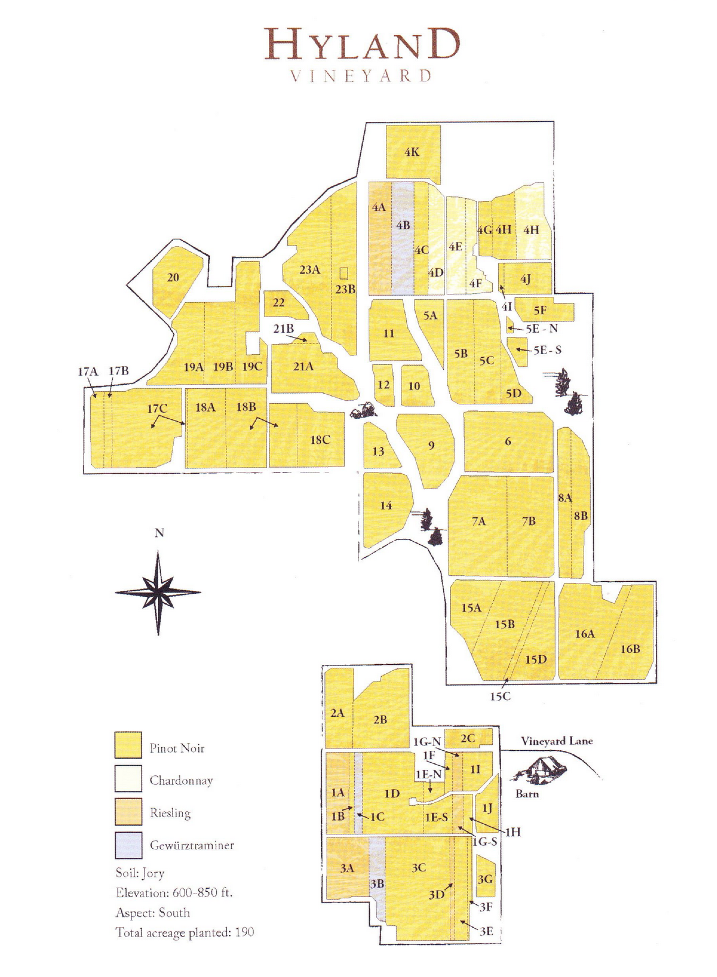
2018 Cristom Old Vine Series Hyland Vineyard McMinnville Pinot Noir
14.0% alc., 175 cases, $45. 29% Coury selection
and 71% Wädenswil clone.
·
Moderate garnet color in the glass.
Very sexy nose with the perfume of cherry, beef spice rub, floral
lift and a hint of sweet oak. Delightful on the palate with layers
of well-spiced black cherry fruit flavor. Perfectly balanced, with
mildly firm tannins and an infusion of refreshing acidity. The lipsmacking
finish has unreal length. When tasted the following
day from a previously opened bottle, the whole cluster-driven
nose was in full bloom, and I could only shake my head while I
drank this extraordinary wine.
Score: 97
2018 Domaine Divio Hyland Vineyard McMinnville Pinot Noir
13.5% alc., 50 cases, $65. I am not sure of
the vine age and clones but was submitted as an old vine bottling.
·
Dark garnet color in the glass. The nose
opens slowly to reveal seductive aromas of forest floor, blueberries, pomegranate, white pepper, spice, and
toast. Richly appointed with purple and black berry fruit flavors. Succulent and fruit-driven, with gentle power,
modest tannins, a persistent finish, and overall, a charming demeanor.
Score: 93
2017 Double Zero (00) Hyland Vineyard McMinnville Pinot Noir
$90. Sourced from one of the oldest blocks of Coury
selection Pinot Noir planted in 1972.
·
Light garnet color in the
glass. The nose is exotic and very pleasing with aromas of fresh
red cherry and berry, spice and terra cotta. The wine is a
chameleon in the glass with ever-changing flavors and nuances.
Light to mid-weight in style, featuring an array of red fruits
backed by a grip of bright acidity, and superb harmony. The
wine really holds on to the finish. Still exceptional when tasted
the following day from an opened bottle. This wine grows on
you.
Score: 95
2012 Hyland Estates Founders Selection One Barrel Hyland Vineyard McMinnville Pinot Noir
13.8% alc..
·
Moderate garnet color in the glass. Nicely perfumed with scents of black cherry, raspberry puree, tilled earth
and toasty oak. Mid-weight plus in heft, with a rich core of black cherry fruit with hints of spice and rare beef.
The still-evident tannins led to a bit of astringency on the finish that had good but not exceptional length.
Score: 92
2017 Hyland Estates Coury Clone Hyland Vineyard McMinnville Pinot Noir
13.3% alc., $64.
·
Moderately light
garnet color in the glass. This wine aims to please in every way.
The nose is highlighted by aromas of revered cherry, spice,
sandalwood, and even a whiff of white stone fruits. Moderately
light in weight, with a stream of deep cherry and strawberry fruit
goodness. Both appealing grace and refinement with a
generous red cherry-driven finish. Nothing beats that old vine
character.
Score: 94
2018 Hyland Estates Coury Clone Hyland Vineyard McMinnville Pinot Noir
14.1% alc., $60. A limited
barrel selection from own-rooted vines in the oldest blocks of the vineyard.
·
Moderately dark garnet color in the
glass. Terrific nose kicks off the pleasure with aromas of dark red cherry, blackberry, spice cabinet and tilled
earth. Earth-infused with plenty of umami, this mid-weight plus wine delivers loads of sweet black cherry and
blackberry fruit flavors with a shade of oak. A joyous wine.
Score: 94
2019 Hyland Estates Coury Clone Hyland Vineyard McMinnville Pinot Noir
13.3% alc., $60.
·
Moderate
garnet color in the glass. Aromas of dark cherry, black raspberry and confected purple grapes are appealing. A
black cherry cola delight with balanced tannins and a glorious 45-second quenching finish. Full of well-ripened
fruit but discreetly composed. Still attention-grabbing when tasted the following day from a previously opened
bottle. Still young and most certainly will go the distance.
Score: 94
2018 Hyland Estates Founders Selection Hyland Vineyard McMinnville Pinot Noir
14.1% alc., $110. A
blend of the four best barrels of the vintage. An historic selection from vines in the founding vineyards.
·
Moderately dark garnet color in the glass. Initially reserved aromas that open gradually over time revealing
rilled earth, mulch, purple berry and spiced cherry aromas. A big gulp of black cherry and blackberry fruits
assembled in a mid-weight plus style. Riper and darker fruited in character but with gentle power. Impeccable
harmony with a very long, sweet-fruited finish. This wine deserves a few years in the cellar and will prove very
age worthy.
Score: 94
2017 Hyland Estates Block 3c Winemakers Series Hyland Vineyard McMinnville Pinot Noir
13.6% alc., $72.
·
Moderately
light garnet color in the glass. Alluring aromas of dark cherry
compote, potpourri, and ripe strawberry. Instantly enjoyable,
with an appealing juiciness. A soft, gregarious mouthfeel
satisfies as does the mid-weight core of vivid cherry fruit.
Almost ephemeral, with fine-grain tannins and a lengthy, red
cherry-driven finish.
Score: 95
2017 Hyland Estates Block 6 Winemakers Series Hyland Vineyard McMinnville Pinot Noir
13.7% alc.,
$78.
·
Light garnet color in the glass. A combination of red cherry, potpourri and baking spice aromas lead the
way. Exotic and elegant in a lighter-weighted style offering flavors of earth-blessed cherry, wild strawberry and
red licorice. A shade of oak and congenial tannins are complimentary. The finish is suave and lengthy.
Score: 93
Sokol Blosser Estate Vineyard
Sokol Blosser Estate
Owners: 1966 Stanford graduates Susan Sokol and Bill Blosser first planted grapes in the early 1970s and Sokol
Blosser Winery was founded in 1977. Since 2008, second-generation siblings, Alex and Alison Sokol Blosser,
are a the helm. Alex became vineyard manager in 2006 when his mother retired and moved on to head
winemaker in 2014 when long-time winemaker Russ Rosner retired. Alison is the CEO and head of sales and
marketing. Both Alex and Alison hold the title of co-president.
Location: West of Highway 99W in Dayton in the Dundee Hills AVA of the Willamette Valley.
Planting: In 1970, the Sokol Blossers purchased land in the Dundee Hills that was a former prune orchard. In
1971, they cleared their land and planted wine grape cuttings in a nursery row. The first 2-acre block of Pinot
Noir was planted in 1972. The initial planting also included 1 acre of Müller-Thurgau, 1 acre of Chardonnay
and 1 acre of White Riesling. Planting ensued during the early 1970s. The entire vineyard was replanted from
1998-2009 due to phylloxera. The original section of the vineyard planted to Pinot Noir were replanted in 2007
and 2009 using cuttings taken from the original fruiting vines and grafted onto phylloxera-resistant rootstock for
the replant. Currently, there are 89 acres of vines on the 128 acres of estate property. 72 acres are planted to
Pinot Noir with small amounts of Pinot Gris, Riesling, Chardonnay and Müller-Thurgau. Dijon clones 115, 667
and 777 and Pommard were added to the vineyard in 2001.
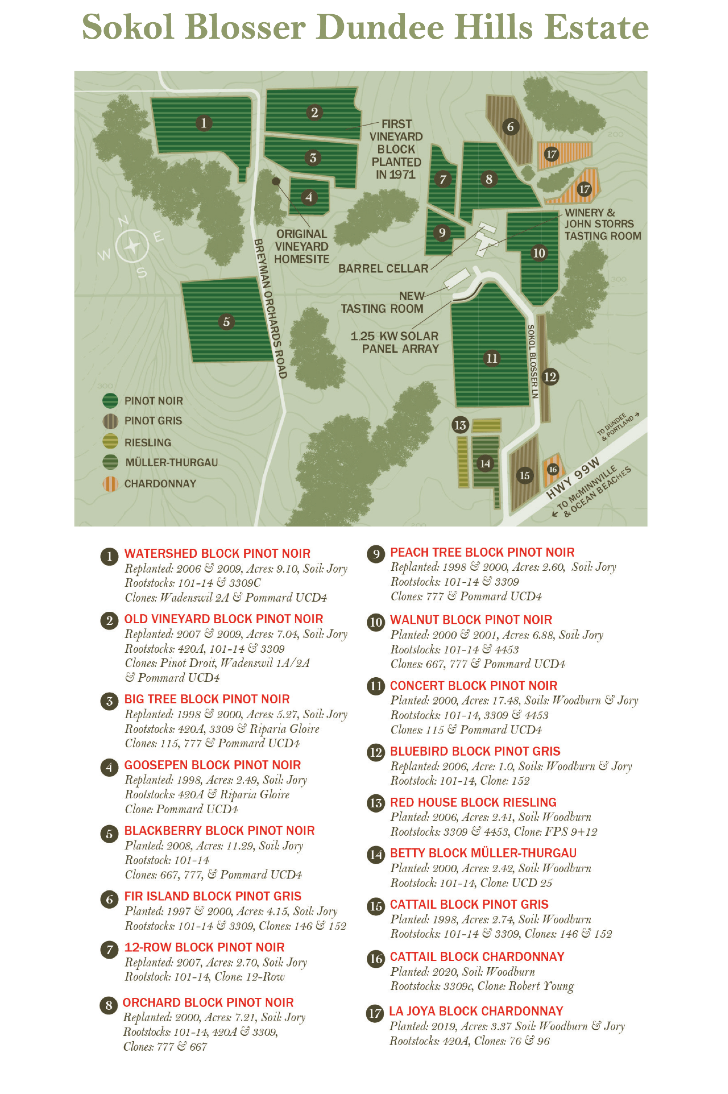
Pinot Noir scions: Own-rooted Pommard, Wädenswil 1A and 2A, .and unidentified Pinot Noir clone/selection that may be a Martini clone.
Soil: Red, volcanic Jory.
Vines: Original vine spacing was 20’ x 6’. The vineyard is at 200’-450’ elevation.
Farming: USDA organically certified in 2005, and also LIVE, and Salmon-Safe. The first Oregon winery to be certified
Salmon-Safe. The winery is currently at the vanguard of mechanical harvesting of Pinot Noir in Oregon.
Winery clients: None, a monopole.
Old vines bottlings: The Twelve Row Estate Pinot Noir is based on one of the original sites planted in the
early 1970s. The family thought they were sold a Pommard clone but it turned out to be an atypical clone of Pinot
Noir that has not been identified but may be a Martini clone. The Watershed Block Estate Pinot Noir is from a
section of the vineyard planted by the founders in the early 1970s. It was replanted in 2006 and 2008 using
cuttings taken from the original plantings of Wädenswil 2A and Pommard 4 and grafted onto rootstock. The Old
Vineyard Block Estate Pinot Noir is produced from fruit harvested from the initial section of the vineyard
planted by the founders. It was replanted in 2007 and 2009 using cuttings taken from the original plantings of
Wädenswil 1A and 2A, Pommard, and Upright Pinot and grafted onto rootstock for the replant.
Of Interest: I graduated from Stanford the year before (1965) the Sokol Blossers did but I don’t recall knowing
them. It was, however, the Stanford connection that led me to stop in at Sokol Blosser in the early 1980s, the
first Oregon winery I ever visited. The winery is celebrating its 50th Anniversary.
2018 Sokol Blosser Watershed Block Estate Dundee Hills Pinot Noir
14..2% alc., 350 cases, $85.
Pommard and Wädenswil clones. Aged 30 months in French oak barrels.
·
Dark garnet color in the glass.
Aromas of blackberry, dark chocolate, muddy earth, and toasty oak. A robust wine in a mid-weight plus style
donating a big mouthful of beautiful boysenberry, blackberry and black raspberry fruit flavors backed by plenty
of winter Wassail spice and a noticeable compliment of oak. Very silky on the palate with a lengthy finish. A
sense of alcohol peeks out as the wine warms in the glass. When tasted the following day from a previously
opened bottle, more rustic oak was evident in the background.
Score: 91
2018 Sokol Blosser Twelve Row Block Estate Dundee Hills Pinot Noir
14.0% alc. 400 cases, $85. A
section of the vineyard planted to 11 rows of Pinot Noir and 1 row of Riesling, Expanded to 36 rows in 2007.
Martini clone.
·
Moderately dark garnet color in the glass. A chameleon in the glass with a range of aromas
including boysenberry, plum, mocha java, tilled earth, and terra cotta. Gentle richness on entry with layers of
purple and black fruits that are vivid and juicy. Impeccable harmony with modest supportive tannins and oak,
and a sleek, persistent finish that goes on and on. Still pumping out considerable fruit goodness when tasted
the following day from a previously opened bottle.
Score: 95
2018 Sokol Blosser Old Vineyard Block Estate Dundee Hills Pinot Noir
14.0% alc., 500 cases, $60. This wine
celebrates 50 years,1971-2001, as well as a tribute to the
founders.
·
Moderately light garnet color in the glass. Initially
reserved nose, opening beautifully over time to reveal enticing
aromas of dark red cherry, dark strawberry, baking spices and
sandalwood. Very elegant with tender power in a mid-weight
style offering flavors of dark red cherry, raspberry and
strawberry fruits. Firm, supportive tannins with a sexy, silky
texture. The finish is extraordinarily long and generous. A
superb wine in every way and a fitting tribute to 50 years.
Score: 96
Oak Knoll Vineyard
Owners: Rob and Marjorie Vuylsteke founded the Oak Knoll winery in 1970, the first winery in Washington
County. They started with a 5-acre property that had previously been the Oak Knoll Diary. Various members of
the family have had partial ownership and involvement in the company through the years including head
winemaker Jeff Herinck (a cousin), step-son Greg Lint, and son Steve Vuylsteke. The family still has some
ownership in the winery.
Location: Tualatin Valley in Hillsboro, Washington County in the Chehalem Mountains AVA.
Planting: Initially, the family sourced grapes for wine production and the first vintage of Pinot Noir was 1973.
According to Steve Vuylsteke, a vineyard was planted on the property in the 1970s that included cuttings of
Pinot Noir sourced from Richard Sommer at HillCrest Vineyard. The low elevation of the vineyard led to
repeated grape frost damage and the vines were eventually pulled out.
Pinot Noir Scion: Uncertain.
Old vines bottlings: None.
Of Interest: By the mid-1980s, Oak Knoll Winery became well known for Pinot Noir. In 2006, the winery was
the largest in Washington County with an annual production of 30,000 cases. According to Steve Vuylsteke,
Pinot Noir was sourced from a number of vineyards in the early years and they are listed chronologically here: DION
Vineyard (starting with a small crop in 1974), Hubris Vineyard (a small vineyard planted by Ken Moyle located
not far from Cooper Mountain Vineyard), Bangsund Vineyard (planted by John Bangsund in the Hood River
area - some of the Pinot Noir from Bangsund Vineyard went into the 1980 vintage of Oak Knoll Winery Pinot
Noir and this was anointed by Andre Tchelistcheff, a judge at the 1983 Oregon State Fair Wine Competition, as
“one of the finest Pinot Noirs he had ever tasted.”), Shafer Vineyard Cellars, Beran Vineyard (now Ruby
Vineyard), Van Schepen Vineyard (now Blizzard Wines), Cooper Mountain Vineyard (before they started their
own winery), Weber Vineyard (began purchasing Pinot Noir from owner Art Weber in the early 1980s), and
Wirtz Vineyard (purchased Pinot Noir from dave Wirtz in the early 1980s). There were no formal leases with
only handshake agreements.
Bangsund Vineyards
Owner: John Bangsund
Location: Columbia Gorge AVA, 20 miles east of The Dalles
Plantings: Initial plantings including own-rooted Pinot Noir in the “1970s.” The Pinot Noir block is 1.5 acres
and still productive. The upper blocks of Cabernet Sauvignon and Syrah are planted across the hillside on
terraces with split canopies. There is also a small block of Riesling lower than the Pinot Noir blocks. The
vineyard has a total of 15 acres.
Pinot Noir scion: Stock cuttings of unknown clones gathered from Henderson’s Vineyard in Washington. The
cuttings were cleaned and rooted before planting.
Vines: The Pinot Noir block of 1.5 acres is planted to 9’ x 8’ spacing. The vines have been cut back and regrown
from the crown a couple of times due to winter damage. Currently, two trunks are being trained into a V
shape with the head of each trunk fastened to the fruiting zone trellis wire about 4 feet apart with a 2-foot
lateral arm in each direction from each head. The vineyard aspect for the Pinot Noir block is from northeast to
southeast at 400' - 500' elevation.
Farming: The vineyard is drip-irrigated and fertilized by ground or foliar depending on soil, leaf or petiole tests.
Winery clients: Bangsund Vineyards supplied Pinot Noir grapes to Oak Knoll during the 1970s. More recently,
clients for all vineyard grapes included Cathedral Ridge, Marchese, Hood Crest, Flerchinger Vineyards (owned
by Cathedral Ridge), Ovum Wines and some home winemakers.
Old vines bottlings Cathedral Ridge Winery in Hood River is known for bold, red Oregon wines but produced
a Bangsund Vineyard Reserve Pinot Noir from old vines in some vintages (at least 2011 and 2016).



